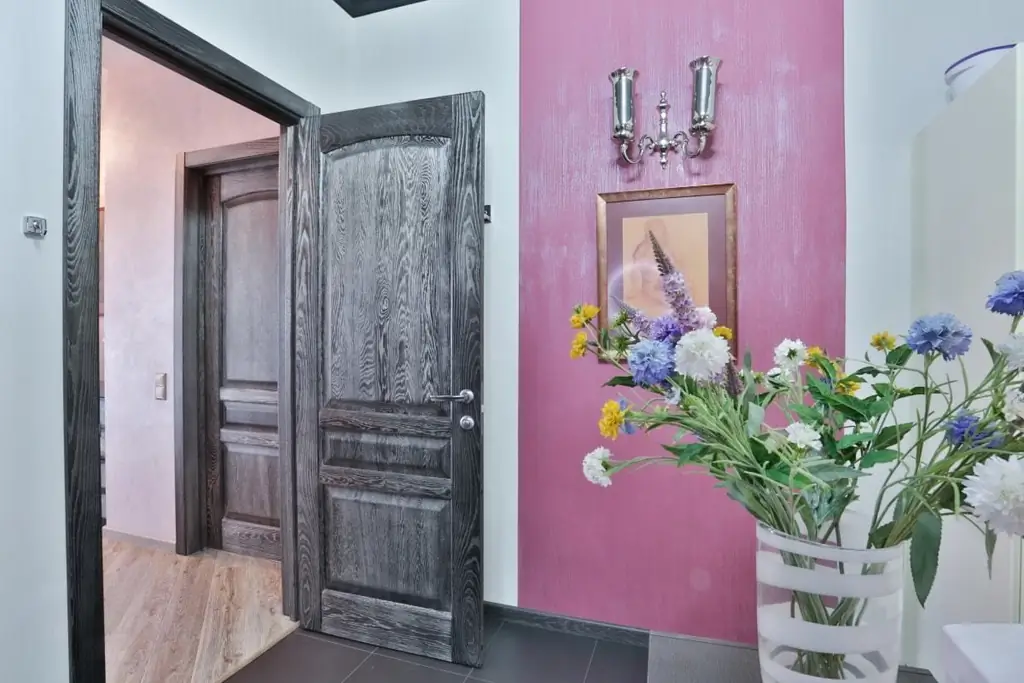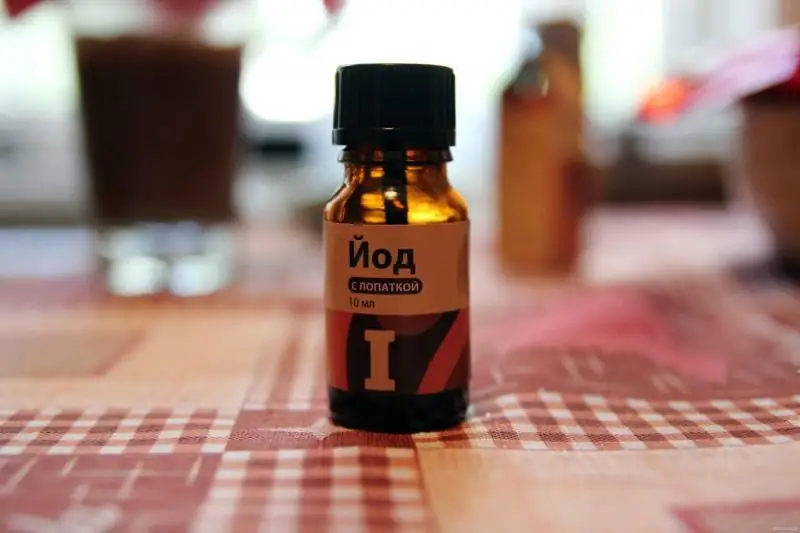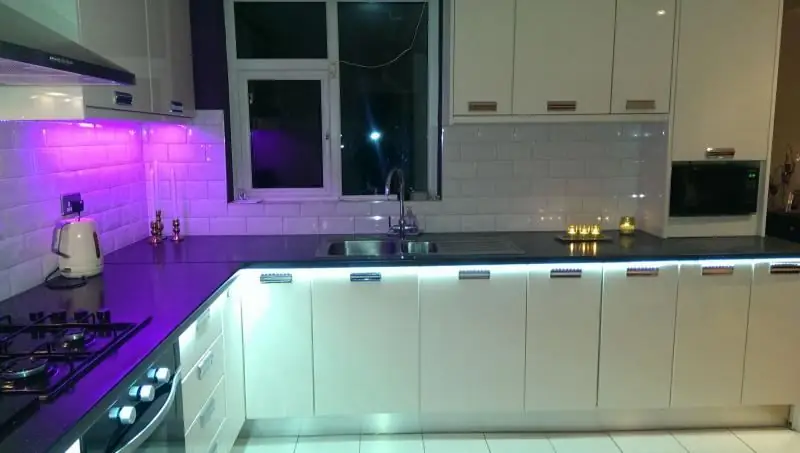
Table of contents:
- Author Bailey Albertson [email protected].
- Public 2023-12-17 12:53.
- Last modified 2025-01-23 12:41.
Oversized doors: ways to age the door leaf

It is incredibly fashionable, although very expensive, to specifically include objects that have survived the centuries into a modern interior. But this is not a reason for frustration, because the purchase of rarities can be safely abandoned in favor of self-aging wooden furniture in the house. For example, aged doors in a special way can easily give a room a mysterious archaism.
Content
-
1 Methods for aging doors
-
1.1 Preparatory activities
1.1.1 Video: Removing old paint as preparing a door for aging
-
1.2 Brushing
1.2.1 Video: how to make wood older with cracks
-
1.3 Patination
1.3.1 Video: door decoration with patina
-
1.4 Formation of abrasions
1.4.1 Video: How wax creates abrasions on wood
-
1.5 Staining
1.5.1 Video: what happens to wood after staining
-
1.6 Crackling
1.6.1 Video: How a one-piece craquelure turns a wooden product into an antique
-
1.7 Chemical treatment
1.7.1 Video: impact on wood with alkali
-
1.8 Thermal method
1.8.1 Video: decorative wood firing
-
-
2 Tips for aging a door
- 2.1 Table: relationship between interior style and door aging technique
- 2.2 Video: old boards as an element of loft style
Doors aging methods
To bring something alternative to the interior, the designers have developed a lot of options for artificial aging of the door leaf.
Preparatory activities
No matter how different the ways to make the door archaic, the preparation for these works is the same. It includes:
- Dismantling the door leaf and removing the fittings.
- Scraping off old paint or varnish with a rubber trowel after special heating with a building hair dryer.
- Puttying the surface in order to mask cracks and other defects.
- Sanding aimed at eliminating unevenness.
Further actions depend on what you want to achieve by aging the door.
Video: removing old paint as preparing a door for aging
Brushing
By applying brushing, you can change the pattern and color of a door leaf made of wood of almost any species, excluding maple, alder, cherry, pear and beech. The technology is based on the removal of the fibers of the top layer of wood with a metal bristle brush and the use of dyes in black, orange, green, purple or red tones, transforming ordinary forest material into exotic.

After brushing, the door looks spotty because it has dark and light areas contrasting with each other.
Brushing is performed as follows:
- The door leaf is slightly moistened with water and carefully scrubbed with a metal brush, moving it only in the direction of the fibers. To speed up this process and spend less effort, a metal pile brush is placed on the grinder.
-
The metal brush is replaced with a special brush-attachment (when using a grinder) or a piece of sandpaper. They drive on a wooden surface until it gets rid of roughness and lint.

Grinder with a special brushing attachment A grinder with a special nozzle allows you to remove the top layer of wood and level the door leaf
- Taking a chisel, the wooden canvas is streaked with grooves, which will give the impression that the wood has already been covered with cracks from old age and has chips.
- Surfaces are perfectly smooth by sandpapering.
- A coloring emulsion is applied to the door leaf, which can give the wood a juicy color, or a stain. In order to achieve a spectacular look, the product is coated with a paint consisting of a metal powder resembling gold or silver. Hidden in the pores of the wood, a special pigment will shimmer when the door is illuminated by the sun's rays.
- The wooden surface is sanded and treated with either wax or varnish.
Video: how to make wood older with cracks
Patination
Patinating is resorted to in an effort to give an ordinary wooden product a more interesting look with a touch that emphasizes the beauty of the carving
To create a film on the surface of wood, use acrylic paint or special varnish in brown, gold, red and green shades.
To this end:
- The door leaf is put in order with a rag and sandpaper.
- The wood is treated with a primer.
-
When the door is dry, a base coat is applied to it - a coloring agent of a suitable, for example, green shade (patina).

The process of processing a wooden object with patina Patina allows you to make the color of the wood more interesting and uneven.
- After 24 hours, the initial layer of paint is sanded with sandpaper and treated with color again.
-
Some areas of the door are smeared or sprayed with paint with a golden or bronze tint, specifically increasing the degree of aging of the door leaf.

Door after patination Some parts of the door are covered with paint in a golden hue, which makes the impression that the door is antique is enhanced
- To give the color juiciness, the wooden surface is treated with matte or glossy varnish.
Video: door decoration with patina
Abrasion formation
Wanting to nobly age the door, they create abrasions. Their appearance is achieved by means of wax or paraffin.
The door is treated with a viscous substance as follows:
- The door leaf is covered with a dark paint and dried for two days.
-
Some areas of the door are smeared with wax. They do not try to make any drawing - the viscous composition is applied randomly.

Wood wax Wax will make some parts of the wooden product brighter, which will make it seem that other parts of the door are frayed
- The wood is re-painted, but for this they use a composition several tones lighter than the one applied earlier.
- Wax is carefully scraped off the canvas, under which are hidden places processed only with a dark coloring emulsion.
- They wait several days for the canvas to completely dry out, and then they diligently rub it with sandpaper.
-
The old look acquired by the door is emphasized with a stain that can highlight the texture of the wood.

Colored wax door The door can be treated with not only simple but also colored wax
Video: how wax creates scuffs on wood
Stain treatment
For painting the door with a stain, or, in other words, blackening, they undertake, wanting to add several decades to the age of the door in an easy way. The problem is solved step by step:
- Solid wood is kept for several days in a place that is well ventilated, thereby allowing the material to get rid of dampness.
- The wooden cloth is rubbed with sandpaper, moving along the fibers.
-
In order to find out how well a wooden product can absorb the blackening composition, a special test is carried out: the stain is applied to a board made of the same wood as the door. Often after that, they come to the conclusion that one layer of a special tool will not be enough.

Test staining To determine the number of layers of stain, the product must first be applied to the test board.
-
Using a brush, rag or sponge, stain the wood door with quick movements. Until the composition has time to dry, it is spread over the surface with a dry and soft cloth, removing excess. Usually the product is treated with stain in 2-3 steps.

Stain door treatment process The stain is smeared on the wood with quick movements, working with gloves
- After waiting until the surface of the door is completely dry, sand it with a piece of rough cloth. First, a rag is carried along the wood fibers, and then diagonally.
-
A door with a thick layer of stain is treated with varnish or wax.

Doors after staining Stained doors look pretty picturesque
Video: what happens to wood after staining
Cracking
An interesting way to age a door leaf is to sprinkle it with cracks. The technique is called cracking and involves the use of a special kind of paint, through which you can see which coating was applied to the surface first.

Crackling creates an uncomplicated mesh pattern on the door
Craquelure on the door surface can be one- and two-component. The first option is simple and can be applied at home, and the second is difficult, which is why it is suitable only for masters engaged in the creation of rare things and the restoration of old art objects.
A one-component craquelure on the door is created step by step:
- The door leaf is dried and wiped with sandpaper, eliminating minor wood defects.
- Two acrylic paints of contrasting colors are selected, the difference between which is clearly visible. One of the compositions should be darker and the other lighter.
- Apply the first layer of paint with a roller or a wide brush over the wooden product. What it will be - light or dark - does not matter.
-
As soon as the initial layer of the coloring matter hardens, a special varnish is applied to the surface to create a special pattern - crackle. If you want the wrinkles to be especially deep, the composition is smeared with a thick layer.

Composition for crackle To create a crackle coating, you need to use a set of special paints and varnishes
-
Without waiting for the first layer of the paint emulsion to dry, the door is painted again using a composition of a different tone and a brush with soft bristles that will not scratch the fragile shell with crackle.

Crackle application process The applied crackle after a while becomes covered with cracks
- Noticing that cracks appeared on the door, indicating the hardening of the crackle composition, the surface of the product is treated with a finishing acrylic varnish.
A two-component cracking, reminiscent of a long-cracked lacquer coating over a pattern (such as a painting), appears on the door as follows:
- The wooden product is degreased by wiping with white spirit, dried and sanded, removing burrs.
- In several approaches, the surface is treated with shellac alcohol varnish, which improves the adhesion of all compounds to wood.
- After making sure that the door is dry, the crackle agent is applied in two layers. The second layer of a special composition is used after the first has hardened.
- Dried craquelure, that is, a coating with cracks that has appeared, is painted over with oil paint or grated pastels.
Video: how a one-piece craquelure turns a wooden product into an antique
Chemical treatment
Chemicals are capable of giving a wooden piece of interior an antique look: ammonia, alkaline products used to clean kitchen stoves, and copper sulfate.
Chemical aging of a door is only permitted if it is made of hardwood, i.e. ash, oak, poplar, beech, cherry and maple. In a word, tannins must be present in the material of the door leaf for processing with special chemistry.

Due to chemical treatment, especially dark stains can be obtained on the door
Chemical door processing includes the following steps:
- The wooden surface is leveled with fine-grained sandpaper.
- The door is covered with chemistry.
-
After a few days, during which the reagent hardens on the surface, the excess is removed from the finished coating using a wire brush.

Wire brush A wire brush is needed to remove excess material from the door surface
- The wood is cleaned with water with a low acid content and, if it has acquired the required appearance, it is gently rubbed with fine-grained sandpaper.
- After a day, if necessary, to achieve a more pronounced effect of aging, duplicate the treatment of the door with chemistry.
Video: exposure to wood with alkali
Thermal method
The relief and rich dark color of a wooden door can be endowed with heat treatment. Blow torch or gas torch firing is excellent for softwood products.

Thermally aged doors will appeal to those who like the relief of wood
To burn a wooden canvas, you need:
- Remove any burrs from the surface by rubbing it with sandpaper.
-
Burn the product to the required degree.

Thermal wood treatment process After firing, the wood becomes almost black
- Remove carbon deposits from the blade with an abrasive disc mounted on a drill or a wire brush.
- If it is necessary to make the contrast between light and dark areas more pronounced, stain the wood surface.
- Give the wood a beautiful shade with shoe polish or ink, or better with a special oil.
- Smooth the surface with sandpaper to remove excess wood fibers.
- Treat the product with furniture wax.
Video: decorative wood firing
Tips for aging a door
To own a truly cozy home, in which you can see the beauty, emphasized by the effect of antiquity that fits well into the atmosphere, you need to decide in advance what the architectural style of the building and the design of the room will be.
Artificially aged wooden objects will not spoil, but will decorate the interior if it is designed in the following directions:
-
the style of a Russian estate, where the stove stands in the middle of the house, surrounded by wooden objects devoid of any frills;

Russian estate style room A room decorated in the style of a Russian estate can only be filled with simple, artless interior items
- Art Nouveau, paying close attention to the smallest details and bringing architecture closer to the visual arts;
- alpine style (chalet), based on a combination of brick, wood, painting and parquet;
- baroque, striving for grandeur and splendor, that is, the use of chicly finished wooden furniture, especially those that are gilded;
-
Victorian and Gothic styles, which are characterized by an ensemble of stone and wood and dark colors - brown and black;

Gothic style room A room decorated in a Gothic style loves darkness, that is, it needs wood, which was specially given a black shade
- classicism, emphasizing the expansion of space, an abundance of rich decorations, harmony and noble colors of decoration;
- rural style (country), the differences of which are dull colors, unpainted wood, brickwork and decorative plaster;
-
Rococo, characterized by an abundance of curved shapes, gilding, artistic carving, mosaics and natural wood;

Rococo room The rococo room resembles the royal chambers, as gilded furniture is placed in it
- German style, which requires furnishing rooms with lacquered, gilded or unpainted products with curved lines, because it is characterized by sentimentality and convenience.
This does not fit into the generally accepted idea of old wooden things, but, according to the designers, antiques are perfectly combined even with the industrial-urban style of the loft, which made itself felt in the 1940s in Manhattan.

Brick wall and aged wood look organic in the same room
Judging by the description of the styles, for each of them the aged door must be selected individually.
Table: the relationship between interior style and door aging techniques
| Style | Suitable door aging method |
| Russian estate | Brushing, waxing, heat treatment |
| Modern | Cracking, waxing |
| Chalet | Waxing, brushing, heat treatment |
| Baroque | Patination, cracking |
| Classicism | Brushing, waxing |
| Country | Brushing, staining or waxing, heat treatment |
| Rococo | Crackling, patination |
| Gothic | Chemical treatment, staining |
| German style | Patination, waxing |
| Loft | Brushing, staining or waxing |
Video: old boards as an element of loft style
Believe it or not, technological development encourages society to take an active interest in antiques. The increased attention to them is heavenly, for example, an artificially aged wooden door is especially chic and radically changes the atmosphere in the room.
Recommended:
How To Remove Iodine From Clothes And Other Surfaces, Than To Wash It From The Skin, Various Methods And Means + Video And Photo

How to remove iodine from different fabrics, wash stains from furniture, body and other surfaces. Effective ways with instructions for use with photos and videos
Lighting For The Kitchen Under The Cabinets And Above The Working Area: LED Strip And Surface-mounted Lamps To Illuminate The Surface Of The Kitchen Set

Types of LED backlighting, their pros and cons. Options for placing the backlight of the kitchen set. Installation of LED strip and expert advice
Double-leaf Doors: Entrance And Interior Doors, As Well As Their Varieties With A Description Of The Device And Installation

Double-leaf doors: types, standard sizes. Accessories for double doors. Installation stages and operation features. Reviews
MDF Doors: Entrance And Interior Doors, Their Varieties With A Description And Characteristics, Advantages And Disadvantages, As Well As Installation And Operation Features

Doors from MDF: features, characteristics, varieties. Making and installing MDF doors with your own hands. Door restoration. Reviews, photos, videos
How To Make A Man Miss You: Working Methods And Tips

How to make a man miss you. 8 working ways
